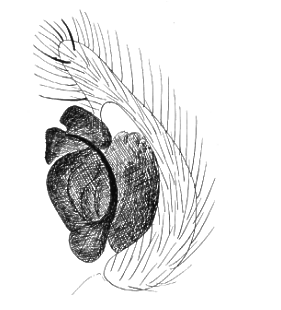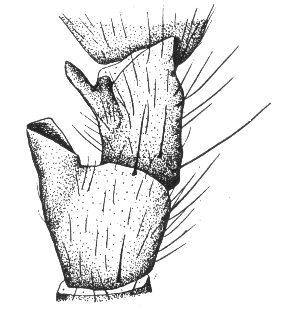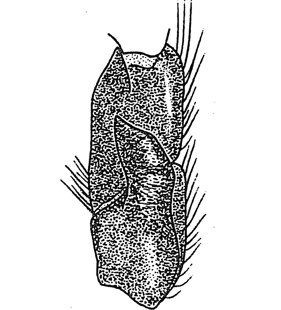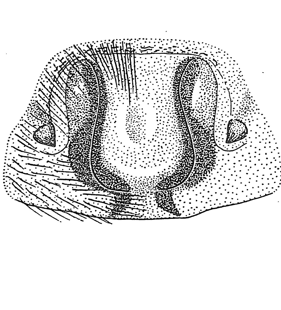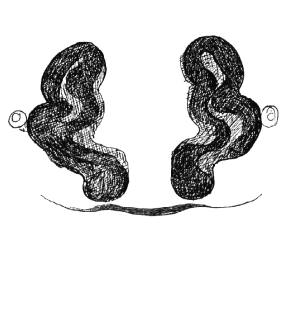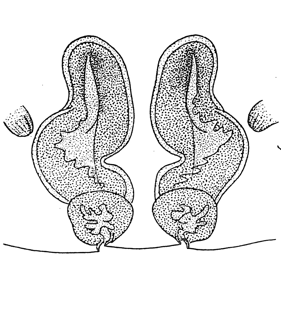Coelotes solitarius L. Koch, 1868
Description
Male palp with patellar apophysis, its distal edge straight. Conductor with broad and rounded tip. Epigyne with vague, straight anterior margin. Prosoma yellow-brown, sides dark brown. Sternum dark red-brown. Legs yellowish red-brown. Opisthosoma dark grey with hardly visible, bright pattern.
Body length male: 10 mmBody length female: 13-15 mm
Additional information
under stones in damp woodland, especially in the Alp and Carpathian area, but also in the lowland
Distribution
Figures
Distribution List
"No references" does not mean that the species does not occur in this country, but that we have not yet inserted the reference for it. We are working on it.
References
Blauwe R de (1973) Revision de la famille des Agelenidae (Araneae) de la région Mediterranéenne. Bulletin de l'Institut Royal des Sciences Naturelles de Belgique 49(2): 1-111 ![]()
Blick T, Finch O-D, Harms K H, Kiechle J, Kielhorn K-H , Kreuels M, Malten A, Martin D, Muster C, Nährig D, Platen R, Rödel I, Scheidler M, Staudt A, Stumpf H, Tolke D (2016) Rote Liste und Gesamtartenliste der Spinnen (Arachnida: Araneae) Deutschlands. 3. Fassung, Stand April 2008, einzelne Änderungen und Nachträge bis August 2015. Naturschutz und Biologische Vielfalt 70/4: 383-510 ![]()
Dahl M (1931) Spinnentiere oder Arachnoidea, VI: Familie Agelenidae. Die Tierwelt Deutschlands 23: 1-136 ![]()
Hirna A, Zhukovets E (2022) Catalogue of spiders (Arachnida, Araneae) of the Lviv oblast (Ukraine). National Academy of Sciences of Ukraine, Institute of Ecology of the Carpathians, Lviv, 311 pp. ![]()
Kostanjšek R, Kuntner M (2015) Araneae Sloveniae: a national spider species checklist. ZooKeys 474: 1-91 ![]()
Le Peru B (2007) Catalogue et répartition des araignées de France. Revue Arachnologique 16: 1-468 ![]()
Loksa I (1969) Pokok I-Araneae I. Fauna Hungariae 97: 1-133 ![]()
Pantini P, Isaia M (2019) Araneae.it: the online catalog of Italian spiders, with addenda on other arachnid orders occurring in Italy (Arachnida: Araneae, Opiliones, Palpigradi, Pseudoscorpionida, Scorpiones, Solifugae). Fragmenta Entomologica 51: 127-152 ![]()
Samu F, Szinetár C (1999) Bibliographic check list of the Hungarian spider fauna. Bulletin of the British Arachnological Society 11: 161-184 ![]()
Thaler K (1997b) Beiträge zur Spinnenfauna von Nordtirol - 3: "Lycosaeformia" (Agelenidae, Hahniidae, Argyronetidae, Pisauridae, Oxyopidae, Lycosidae) und Gnaphosidae (Arachnida: Araneida). Veröffentlichungen des Museum Ferdinandeum in Innsbruck 75/76: 97-146 ![]()
Weiss I, Petrișor A (1999) List of the spiders (Arachnida: Araneae) from Romania. Travaux du Muséum National d’Histoire Naturelle “Grigore Antipa” 41: 79-107 ![]()
WSC (2025) World Spider Catalog. Version 26. Natural History Museum Bern, online at http://wsc.nmbe.ch (28.2.2025) doi: 10.24436/2 ![]()


